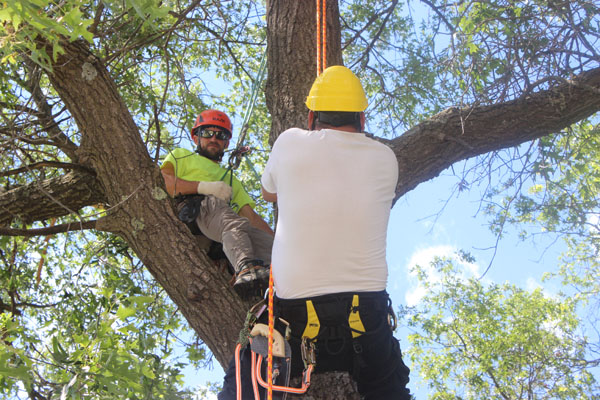Barking up the right tree
By Gabriel Lagarde

Aspiring Ho-Chunk urban foresters are, literally, learning the ropes with the advent of a new training regimen offered for the first time June 21-24 in Black River Falls.
Urban forestry involves the proper usage and care of trees, shrubs and other flora in close proximity to people, housing and other aspects of communities.
Five trainees attended a three-hour class and then spent the following days learning how to climb trees, remove dead or damaged limbs and dispose of them safely.
Mark Gawron, of the Division of Natural Resources, said the program is invaluable to the Ho-Chunk Nation, which he estimated is the most urbanized tribe in the state of Wisconsin.
With the spread of Oak wilt, a destructive fungal disease plaguing the state, removing dead limbs or entire trees is not a matter of landscaping, it’s one of safety for the people that work, play and live beneath their branches.
“We have 13 housing communities with over-mature oak trees with Oak wilt disease,” he said. “That’s not a good situation.”
Gawron said, to his knowledge, the Ho-Chunk Nation is the only tribe that includes an urban forester in its staff and the only one with a program of this kind, a measure that is cost-effective and looks to reap benefits long into the future.
“It’s going to save the nation tens of thousands of dollars,” Gawron said. “There are a lot of trees in our community.”
It was with this rationale in mind that Aaron Schauer, a veteran urban forester, was invited to train members of the Ho-Chunk Nation how to climb and work at daunting heights with little more than ropes and handsaws at their disposal.
Under Schauer’s tutelage, the trainees traveled to the old mission and practiced a double-rope technique of climbing that utilizes leverage, counter-weights and raw strength to hoist the climber into the highest branches, where they are able to prune branches and remove problematic limbs.
Climbers could remove the whole tree if they had to, a methodical, careful process of breaking the tree down segment by segment, in order to protect neighboring residences.
Greg Blick, an urban forester with the Division of Natural Resources, joined the trainees and took the course as a refresher after studying urban forestry at UW-Stevens Point.
He said much of the program was learning a catalogue of complex knots and pulley systems to overcome the challenges presented by the trees. Then, Blick said, it was a matter of trusting the equipment and getting a handle on the physical aspects of the job.
“We’re going to be able to go up into a tree, set a line and then use a set of pulleys to create mechanical advantages,” he said. “We had three guys pull a five-ton truck up a hill with just pulleys.”
Blick said urban forestry, while demanding, is a well-rewarding job. Professional contractors are many times paid north of $25 an hour for the work they do.
For Gawron, the program represents a way for the Ho-Chunk Nation to take ownership of their lands and communities.
“The nation takes better care of our resources with our own staff being trained like this,” he said. “It creates a safer environment.”
Home